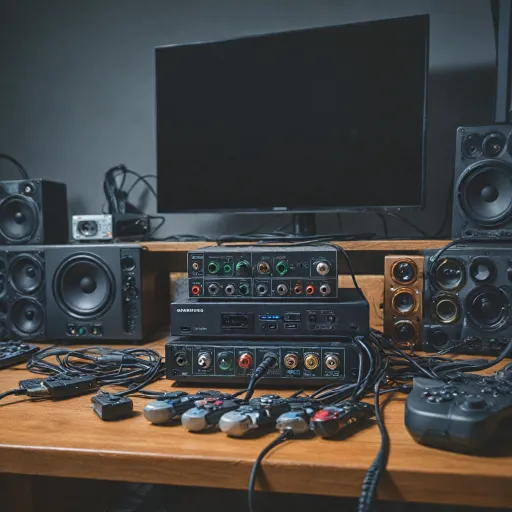
The Evolution of Signal Light Guns
The Early Days of Gun Signals in Gaming
The journey of signal light guns in gaming consoles traces back to the arcade era, where simplicity was king. Initially, these devices were straightforward in design, leveraging basic lamp-based technology to interact with a screen. The concept echoed airport tower lights and ATC signals, adopting cue systems much like those used in air traffic control tower operations. Early signal light guns relied on incandescent lamps, which brought forth a level of interaction comparable to those used in aviation administration, with control towers guiding players through digital 'runways' on-screen.Advancements in Technology
As video game technology advanced, so did the intricacy and capability of the signal light guns. The integration of LED signals marked a significant evolution, providing longer life and higher light intensity, much like upgrades seen in airport signal systems. The LED light variations improved the precision of these gun signals, offering a more immersive gaming experience that required less weight battery and more stable power supply. This evolution mirrored advancements in air and ground traffic control systems, where light intensity and color light coded fixtures were improved for better visibility and function. Even as these light guns became more sophisticated, challenges similar to those faced by aviation's runway light kits persisted. Game developers had to continuously innovate to keep pace with the demand for more realistic and responsive gaming interactions. Explore more on overcoming copyright challenges in preserving Japanese video games to understand the broader hurdles faced in gaming technology advancements.How Signal Light Guns Work
Decoding the Mechanism Behind Light-Signal Guns in Gaming
Understanding the workings of signal light guns involves delving into both the technical aspects and the intricate interactions between the gun, the TV screen, and the console. The technology behind it resembles the precision of airport runway lamps and air traffic control systems, but in the context of a gaming experience. Initially, light guns were quite basic, involving a single detection function. The controller would recognize when a player aimed at the screen and trigger a signal based on the screen's luminosity patterns. Imagine this akin to the careful signal coding at an airport tower light system, where accuracy and timing are paramount. Modern signal light guns have evolved with advancements in LED technology, much like improvements seen in aviation and display intensity properties. These advances allow guns to use LED signals and other sophisticated components to enhance accuracy and interaction with the console. The way a light gun operates is somewhat similar to ATC signal light guides used in air traffic to ensure precision in signaling when directing aircraft ground maneuvers. Key components include:- Optical Sensors: These sensors in light guns detect changes in screen light intensity to determine where the target is defined.
- Infrared LED Systems: Modern systems utilize LEDs akin to tower light systems and are powered by long-life battery kits for sustained performance.
- Screen Timing and Coding: Much like coded communication systems at airports, the console must synchronize signals precisely, ensuring that the aim and response remain true and swift.
- Response and Conversion: Controllers translate the optical data into game actions. This parallels the conversion processes in aviation administration and traffic control where data signals are turned into actionable commands.
Popular Games Using Signal Light Guns
Iconic Games Elevating Light Guns to Fame
Signal light guns, with their unique capability to add realism to gaming, have been integral to some of the most popular video games. These games have leveraged the immersive experience that light guns offer, capturing the interest of gamers and ensuring these controllers retained popularity. One of the most iconic video games known for its innovative use of the light gun was "Duck Hunt" on the NES. This game utilized the NES Zapper, adapting the light gun technology as a primary control method to shoot ducks across the screen—a concept that captured the imagination of a generation. Such games established the foundation for further advancements in gun-based simulation in the gaming industry. Moving beyond traditional systems, wireless signal light guns gained prominence with the release of systems like PlayStation and Xbox. These new-age light guns are not only utilized in shooter games but have also found applications in training simulations, accurately mimicking real-world lighting scenarios to deliver a more authentic experience. Interestingly, many games using light guns have similarities with aviation training, where hand-held light signals communicate effectively on aircraft ground or in control towers. This crossover of technology showcases how gaming innovations often parallel developments in real-world applications, like those seen in airport traffic control or runway systems utilizing LED signals. As light gun technology continues to evolve, future games are expected to further integrate advanced light, LED, and sensor technologies. By employing these components, games can mimic real-world intensities and scenarios, making use of coded signals akin to what you see in aviation administration settings. To learn more about how these advancements shape the console world, explore the features of the EBox 20 for insights into modern signal and lighting technologies in gaming consoles: explore the features of the EBox 20. In summary, while traditional light guns brought novel interactive experiences to iconic games, technological advancements continue to redefine their role, setting the stage for an even more immersive gaming future.Challenges Faced by Signal Light Guns
Technical and Operational Challenges
Signal light guns have been an integral part of gaming consoles, offering immersive experiences. However, they do face several challenges that limit their efficiency and usage. One of the primary issues is related to the light intensity and color light technology used in these devices. As advancements in LED light technology continue, older models may lag in terms of visual quality and responsiveness compared to newer gaming controllers.
Additionally, the light guns have to work in sync with the video output of the game, creating potential synchronization issues. If the coding is off, even slightly, it can lead to a poor user experience. This is especially noticeable when these devices are used for games requiring precise aiming and quick decision-making, akin to air traffic control using signal lamps in an airport.
Another considerable challenge is the power supply and weight of the battery. As technologies advance towards more lightweight and long-life options, existing hand held guns may need upgrades to stay relevant. There's a balance between maintaining authenticity and embracing modernization without increasing weight.
Finally, the physical components such as the base and materials used, impact durability and longevity. Just like aviation administration ensures the control towers and tower lights are up to standards for aircraft ground operations, developers must ensure that the lamp and display elements of signal light guns meet quality benchmarks.
The Future of Signal Light Guns in Gaming
The Upcoming Horizon for Signal Light Guns in Gaming
The gaming industry is marked by continuous evolution and technological advancements. Signal light guns, once a staple in retro gaming, have experienced a decline in popularity, yet they are not absent from the industry's future. The integration of LED technology and the increasing sophistication of gaming systems could breathe new life into these devices. Modern-day light guns could benefit from improved light intensity and color light sensors driven by advances in LED signal and lamp technology. This could allow for better accuracy and responsiveness, rivaling even the most advanced controllers today. Furthermore, innovations in battery technology present opportunities for creating lighter and more energy-efficient signal light guns, which could offer long life and reduce the frequency of recharges. The addition of a robust power supply setup, akin to modern hand-held devices, could facilitate portable options for both niche and mainstream markets. The synergy between aviation and gaming technologies also presents interesting possibilities. Concepts such as coded signals, often used in air traffic control (ATC signal) and airport runway lighting, could inspire new gaming functionalities with signal light guns. This crossover could unlock unique gameplay experiences not previously possible with traditional shooting mechanics. The attitudes of regulatory bodies such as the Federal Aviation Administration in terms of embracing LED technology for tower light and traffic control could serve as a learning opportunity for game developers. Observing the efforts made by these organizations to enhance visibility and accuracy (as seen in control towers and control kits) may inform better design and utilization of signal light guns. Despite these advancements, challenges persist, as detailed earlier. Therefore, while the future appears promising, it requires overcoming hurdles regarding compatibility with new gaming consoles and widespread adoption among gamers. Signal light guns have the potential to be modernized for contemporary gaming experiences. As technologies continue to merge and evolve, there remains a possibility that these devices could find a place in future gaming scenarios, bringing nostalgic thrills with an upgraded twist.Alternatives to Signal Light Guns
Exploring Modern Alternatives to Signal Light Guns
As gaming technology advances, the role of signal light guns is being challenged by new innovations. While these guns have a nostalgic charm and unique functionality, modern gaming consoles are offering alternatives that provide enhanced experiences.
One of the most significant shifts is towards motion-sensing controllers. These devices, unlike traditional light guns, use sensors to detect player movements, offering a more immersive experience. The technology behind these controllers often involves infrared lights and cameras, which track the player's movements with high precision. This method eliminates the need for a CRT display, which was essential for the operation of classic light guns.
Another alternative is the use of augmented reality (AR) and virtual reality (VR) systems. These systems create a more interactive environment by overlaying digital elements onto the real world or immersing players in a completely virtual space. The integration of AR and VR in gaming consoles allows for a broader range of gameplay possibilities that light guns cannot match.
Furthermore, advancements in LED technology have led to the development of more sophisticated gaming peripherals. These devices often feature LED lights that enhance the visual experience and provide feedback to players. The use of LED lights in gaming controllers can mimic the intensity and color of signal lights used in aviation, adding a layer of realism to the gaming experience.
Battery life and weight are also critical factors in the evolution of gaming controllers. Modern controllers are designed to be lightweight and have long-lasting batteries, addressing some of the challenges faced by traditional light guns. The focus on ergonomics and power supply efficiency ensures that players can enjoy extended gaming sessions without discomfort.
In conclusion, while signal light guns hold a special place in gaming history, the industry is moving towards more advanced and versatile alternatives. These new technologies not only enhance gameplay but also offer solutions to the limitations faced by traditional light guns, paving the way for the future of gaming.












